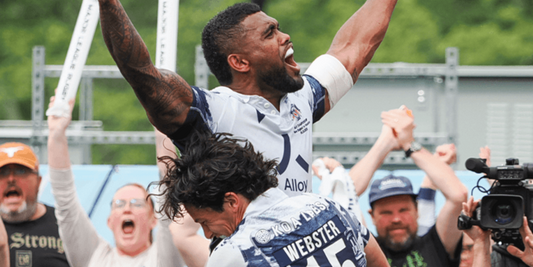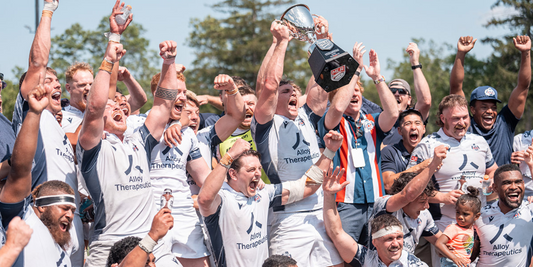If you want to sprint harder, tackle stronger, and protect your spine throughout the grind of a season, you need a strong and functional back.
This article breaks down how to build a resilient, powerful, and rugby-ready back—with exercises that improve posture, reinforce trunk control, and generate explosive strength for scrummaging, sprinting, tackling, and rucking.
You’ll also get access to a downloadable 5-day back training routine with coaching cues, progression tips, and video links to plug straight into your training plan.
Here’s how the series looks like:
- Part 1: How to Build a Strong Core for Rugby
- Part 2: How to Build Strong Legs for Rugby
- Part 3: How to Build Strong Shoulders for Rugby
- Part 4: How to Build a Strong Back for Rugby
- Part 5: How to Build a Strong Neck for Rugby
- Part 6: How to Build Strong Wrists and Grip for Rugby
- Part 7: How to Build Strength for Rugby
- Part 8: How to Build Power for Rugby
- Part 9: How to Build Speed for Rugby
Let’s move to your next foundation: your back.
WHY BACK STRENGTH MATTERS IN RUGBY
Your back is the central support system for movement, impact, and load. It’s not just for pulling exercises—it’s the anchor that stabilizes your spine and transfers force from your legs to your upper body and vice versa.
In rugby, a strong back helps you:
- Generate powerful acceleration and sprint mechanics
- Dominate in scrums, tackles, and rucks
- Maintain posture under fatigue and during contact
- Prevent injuries to the spine, shoulders, and hamstrings
- Improve pulling strength for tackles, mauls, and lineouts
The back isn’t just about thickness or visual size—it’s about structural integrity and total-body force production.
UNDERSTANDING BACK FUNCTION FOR RUGBY
To build a strong rugby back, you need to understand the full system of muscles involved:
1. Lats and Large Movers
Latissimus dorsi, teres major, and trapezius generate power in pulling motions like rows, tackles, and scrums.
2. Posterior Chain
Spinal erectors, glutes, and hamstrings work together to stabilize the spine and drive hip extension during sprints and collisions.
3. Scapular Stabilizers
Middle and lower traps, rhomboids, and serratus anterior ensure shoulder mechanics are clean and force transfers safely through the upper back.
4. Spinal Stabilizers
Deep core and paraspinal muscles like multifidus and quadratus lumborum protect the spine and keep posture strong during lifting and impact.
A rugby-ready back is strong, mobile, reactive, and coordinated.
RUGBY-SPECIFIC BACK DEMANDS
Rugby demands both dynamic and isometric back strength:
- Scrum positioning under heavy load
- Tackling and resisting tackles with strong postural control
- Sprinting and acceleration from posterior chain power
- Pulling and climbing in mauls or lineout lifts
- Bracing the spine in collisions or during rucks
You need to build both muscle and coordination—especially for repeated efforts under fatigue.
THE TRAINING PROGRESSION
Back development should include strength, control, mobility, and conditioning. Here’s how to structure it:
1. Activate and Mobilize
Start by reinforcing posture and movement control:
- Cat-cow and thoracic extensions
- Banded pull-aparts
- Scapular wall slides
- Glute bridges
2. Strengthen and Build Capacity
Use compound and accessory lifts to build muscle and resilience:
- Bent-over rows and chest-supported rows
- Romanian deadlifts
- Single-arm cable or landmine rows
- Reverse hypers and bird dogs
3. Power, Coordination, and Resilience
Add explosive movements and isometric holds:
- Trap bar deadlifts or sled pulls
- Med ball slams from overhead
- Farmer carries and suitcase carries
- Isometric back extensions or holds
Training should progress from mobility → control → strength → power → resilience.
KEY TAKEAWAY: STRONG BACK = STRONG BASE
Your back is the glue between your lower and upper body. It keeps you upright in collisions, lets you dominate physically, and prevents breakdown late in the game.
Train it right—and you’ll feel the difference in every sprint, tackle, and carry. Neglect it, and you’ll feel the strain in every step.
GET YOUR FREE BACK TRAINING ROUTINE
Want a simple, effective back routine you can use to build rugby-specific strength and control? Enter your email below to get your free copy. We’ll send it straight to your inbox.
This free PDF includes 5 rugby-specific back training blocks—each featuring 2 to 3 exercises designed to:
- Build upper and lower back strength
- Improve posture and pulling power
- Reinforce your spine for collision demands
Download it now and start training like a rugby athlete.
If you found this article helpful, don’t forget to:
- Like and share this post with your teammates and fellow rugby fans
- Bookmark the blog to stay updated on the next rounds
- Follow @gopeakrugby on X and Facebook and subscribe to our Youtube Channel for more rugby analysis, match recaps, and insights


















